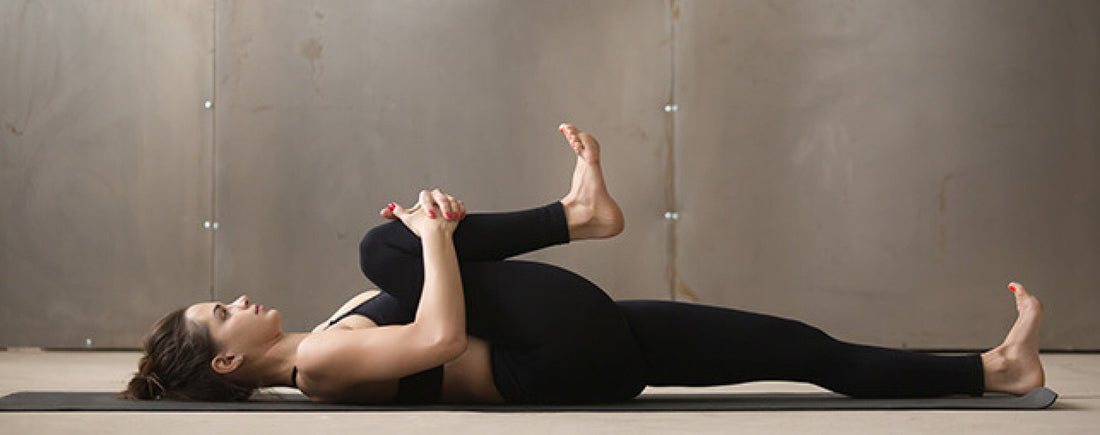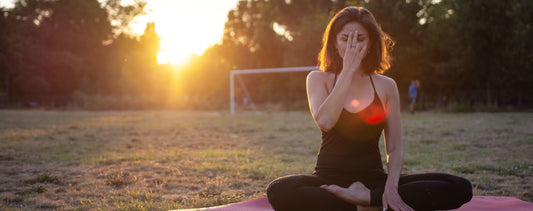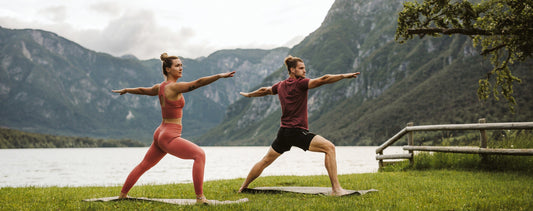The holidays are full of excitement with preparations and the anticipation of spending time with loved ones. It’s easy to get caught up in the “busyness” of it all and forget to stop and engage in some type of self-care activity. Next thing you know, stress takes a toll and you aren’t able to function at your best because your energy has been depleted.
Thankfully, there are helpful tools available to give you the boost you might need—one of them being the practice of yoga. To help you fully embrace the season with both a sense of calmness and good energy, here are some simple yoga poses for all levels that you can do anywhere and anytime.
As you practice, it’s important to keep in mind the following to help you get the most benefit:
awarness-breath.jpg In yoga, great importance is placed on the use of breath as a tool for transformation and is referred to as Prana in Sanskrit, meaning “vital force” or “primordial impulse.” Conscious alterations of the breath through exercises is called pranayama, and when practiced regularly, you can experience improvements in both physical and mental states.
The following breathing exercise is a simple and effective way to begin experiencing the power of the breath and its ability to create calm.
Benefits: Improves quality of breath, quiets and calms the nervous system, reduces stress and anxiety, and increases self-awareness.
Benefits: Increases flexibility in the spine, helping with balance. Aids and regulates digestion, elimination, and metabolism. Helps to relax the mind and body.
Benefits: Lengthens the spine and gently stretches the hips, thighs, and ankles. Soothes the brain and helps relieve stress and fatigue.
Benefits: Assists with elimination. Releases tension in the lower back and increases flexibility in the hips. Nourishes the ascending colon.
Benefits: Releases tension in the lower back, opens up tight shoulders, increases flexibility in the spine, and improves digestion. Helps to reduces stress, anxiety, and depression.
Any time you begin to feel depleted and things get a bit chaotic, take a few minutes to perform any of these poses to encourage a sense of calm. You deserve to experience the love, peace, and joy that comes with this special time of year.
*Editor’s Note: The information in this article is intended for your educational use only and is not a substitute for professional medical advice, diagnosis, or treatment. Always seek the advice of your physician or other qualified health providers with any questions you may have regarding a medical condition and before undertaking any diet, supplement, fitness, or other health programs.
Discover a simple, effortless form of yoga and meditation to help you find peace in each and every moment at Seduction of Spirit, our six-day meditation and yoga retreat with Deepak Chopra.
Thankfully, there are helpful tools available to give you the boost you might need—one of them being the practice of yoga. To help you fully embrace the season with both a sense of calmness and good energy, here are some simple yoga poses for all levels that you can do anywhere and anytime.
As you practice, it’s important to keep in mind the following to help you get the most benefit:
- Move slowly in and out of the poses.
- Keep your breath smooth and even.
- Don’t practice on a full stomach.
- Never strain or force yourself beyond your current abilities.
1. Awareness Breath
The following breathing exercise is a simple and effective way to begin experiencing the power of the breath and its ability to create calm.
Benefits: Improves quality of breath, quiets and calms the nervous system, reduces stress and anxiety, and increases self-awareness.
- Find a comfortable seated position or lay on your back if that feels better. Close your eyes and take a moment to notice your breath without judgement.
- Is it shallow or deep?
- Does it flow easily or strained?
- Where do you feel your breath? Perhaps in the chest, throat, or abdomen?
- After a few breaths, place a hand gently on your lower abdomen to help bring attention here. On the next inhalation, breathe in through your nose, filling the abdomen full with air and feeling it expand like a balloon. Slightly pause at the top of the inhalation and then begin to exhale slowly out the mouth.
- Toward the end of the exhalation, actively engage the abdomen. Imagine pulling the belly button toward the spine, removing all the air. Slightly pause before inhaling again.
- Continue for 6 to 12 complete breaths.
seated-side-bend.jpg2. Seated Side Bend Pose (Parsva Sukhasana)
Side-bending poses feel great on the body and help to release tension by stretching parts of the body you tend to ignore. This variation will be performed seated to allow for deeper comfort. Combined with some deep breaths, this pose can bring in some much-needed energy and vitality to the body.Benefits: Increases flexibility in the spine, helping with balance. Aids and regulates digestion, elimination, and metabolism. Helps to relax the mind and body.
- Sitting in a cross-legged position or Easy Pose, rock side to side slightly ensuring the sit bones are connected to the floor.
- Place the fingertips on the floor in line with the hips, elbows slightly bent.
- Take a deep breath in and elongate the spine. Imagine a thread pulling from the top of your head toward the ceiling. Close your eyes, taking a few moments to connect with the breath.
- Inhale and reach the left arm up and overhead, exhale while leaning toward the right. Keep the sit bones firmly planted on the floor, gazing upward or downward to the floor. Use the right arm to support you in whatever way feels comfortable.
- Hold this pose for 30 seconds or 6 to 8 breaths.
- Switch sides and repeat.
childs-pose.jpg3. Child’s Pose (Balasana)
This restful pose is an important addition to any yoga routine. Often performed in between difficult yoga poses, Child’s Pose can be a much welcomed respite. It is considered a beginner’s pose, but there are many benefits, including reminding you how good it feels to take a moment to pause and rest every once in a while.Benefits: Lengthens the spine and gently stretches the hips, thighs, and ankles. Soothes the brain and helps relieve stress and fatigue.
- Start on your hands and knees with the toes touching.
- Separate knees slightly wider than the hips and lower the sitting bones toward the heels.
- Hinge forward from the pelvis, lowering the torso all the way to the thighs and rest the forehead on the floor.
- Rest elbows, palms, and forearms on the floor in front of you.
- Direct the breath toward the lower back and side ribs. Feel the expansion and release every time you inhale and exhale.
- With each breath, allow the body to sink more deeply into the floor.
- Remain in this position for 4 to 12 breaths.
- To release, place hands underneath the shoulders and slowly press upright into a seated position.
- Pause and notice how you feel.
- Rest the forehead on a block or blanket.
- Roll up and place a blanket behind the knees for extra support.
knee-to-chest.jpg 4. Knee to Chest Pose (Pavanamuktasana)
Also known as “wind-relieving pose” for its gas-releasing benefits, this pose helps to move stagnant energy from the body. The organs are given a bit of a massage that helps to ease worry and tension. Include this in your regular practice not only for its digestive benefits but also for relaxation and peace of mind.Benefits: Assists with elimination. Releases tension in the lower back and increases flexibility in the hips. Nourishes the ascending colon.
- Lie on your back with feet together and arms beside your body.
- Inhale and bring the right knee toward your chest, interlacing the fingers right below the knee.
- Begin to draw the knee toward the shoulder, going around the ribcage.
- Inhale and continue to draw the knee closer to the shoulder. Both shoulders should remain connected to the floor.
- Hold for 30 seconds or 6 to 8 breaths.
- Exhale and release the leg back to the ground and repeat on the other side.
- Now bring both knees up toward your chest, hands placed just below the knees.
- Hold for several moments, inhaling and exhaling. You can move the knees side to side, massaging the spine.
- Release and feel the difference in your body.
reclining-twist-pose.jpg5. Reclining Twist Pose (Jathara Parivartanasana)
Performing this pose can help get rid of emotional fatigue and bring balance to your mind and body. Reclining poses in general have a calming effect, and with the added twist in this pose, there is an extra release of tension and emotions that you may be carrying in your body. It is recommended you try flowing from Knee to Chest Pose directly into this twisting pose.Benefits: Releases tension in the lower back, opens up tight shoulders, increases flexibility in the spine, and improves digestion. Helps to reduces stress, anxiety, and depression.
- Start by lying on your back with both legs extended on the floor.
- Exhale, draw the right knee toward your chest, keeping the back of the head resting on the floor.
- Bring your left hand to the outside of your right knee, keeping both shoulders connected to the floor.
- Exhale, draw the right knee across the body toward the left, allowing the right hip to lift off the mat. The foot touches the floor or rests on the inner thigh.
- Extend the right arm along the floor to the right or bend the elbow at a right angle depending on which feels more comfortable. Palms face up.
- Turn your head toward the right arm for a deeper stretch.
- Close your eyes and direct the breath toward the hips and lower back for 30 seconds or 3 to 6 breaths.
- Draw the right knee back toward your chest and now bring both knees toward the chest for a nice even stretch.
- Repeat on the other side.
Any time you begin to feel depleted and things get a bit chaotic, take a few minutes to perform any of these poses to encourage a sense of calm. You deserve to experience the love, peace, and joy that comes with this special time of year.
*Editor’s Note: The information in this article is intended for your educational use only and is not a substitute for professional medical advice, diagnosis, or treatment. Always seek the advice of your physician or other qualified health providers with any questions you may have regarding a medical condition and before undertaking any diet, supplement, fitness, or other health programs.
Discover a simple, effortless form of yoga and meditation to help you find peace in each and every moment at Seduction of Spirit, our six-day meditation and yoga retreat with Deepak Chopra.






















